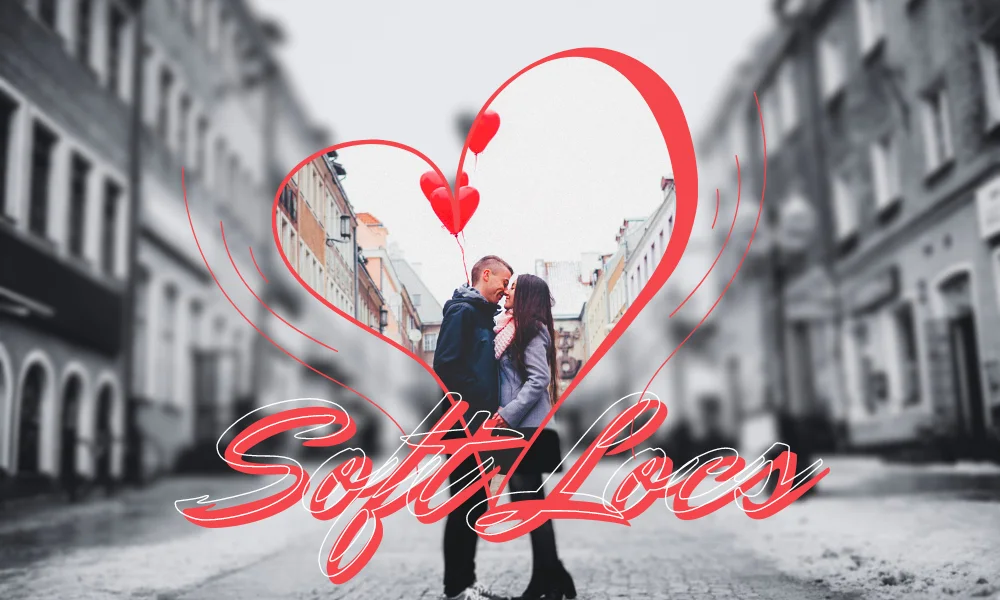Soft Locs
A Detailed Guide to Achieving and Maintaining Them
Introduction: As a stylish and adaptable hairstyle that blends the beauty of traditional dreadlocks with a more relaxed and manageable appearance, soft locs, commonly referred to as “soft dreadlocks,” have become increasingly popular.
This hairstyle is appropriate for a variety of hair types and textures and provides a distinctive means of expressing individuality while taking advantage of low-maintenance.
What You Should Know About Soft Locs
These days, faux locs come in a variety of sizes and styles. But I won’t lie; even I have trouble remembering the differences between soft locs, the newest style to gain popularity, and boho locs, butterfly locs, goddess locs, and even locs with butterflies in them.

Soft locs are easier to style than standard faux locs because, as the name implies, they are softer and move more when they are first implanted.
According to hairstylist Erin Courtney of Style Seat, “the type of hair used is the key to getting the soft locs hairstyle.”
“I prefer kinky wrapping hair because it can be wrapped, but crochet faux locs are also a good option because they don’t require you to wrap your hair down completely.”
Soft locs are a terrific temporary alternative and appear natural if you desire a dreadlock-like style but aren’t ready to commit to it long term.
We requested Courtney to provide all the information you need to know prior to obtaining soft locs, and she did.
Soft Locs Styles
Soft locs have become a popular and adaptable hairstyle that expertly combines the grace of classic locs with a more laid-back and feminine appearance.
This article explores the different ways to sport this effortlessly exquisite hair trend by delving into the enticing realm of soft locs styles.
Soft Locs Hair
Soft locs, a distinctive variation on conventional locs, have taken the hairstyling industry by storm. These looks incorporate a softer texture and a lighter feel while yet maintaining the recognizable loc look.
Soft locs are now a popular alternative for people looking for a style that combines elegance and ease because of their natural and carefree appearance.
Similar steps are used to create soft locs as well as standard locs. The type of hair utilized and the amount of tension employed during installation are the main differences, though.
You’ll need premium synthetic hair or yarn that closely matches the texture and shade of your hair to get started.
How Do Soft Locs Work? A Complete Justification
A modern and adaptable hairstyle choice, soft locs blend the appeal of traditional dreadlocks with a softer and more individualized approach.
Soft locs are produced through an intentional and controlled procedure that involves adding extensions to resemble the appearance of locs, as opposed to traditional locs, which form naturally through the matting and tangling of hair over time.
With this technique, people can have the desired locs look without having to commit over an extended period of time or risk damaging their natural hair.
How Should Soft Locs Be Taken Care of?
You’ll need to give your soft locs hairstyle a little TLC if you want it to last longer than a week. First off, you must cover your soft locs before jumping into bed because doing so will cause them to get frizzy and possibly loosen.
Wearing a silk or satin cap or scarf at night to stop the soft locs from becoming frizzy while you sleep is the ideal way to care for soft locs, according to Courtney.
The hairstylist also advises using a shower cap while taking a shower to avoid getting the soft locs wet, as doing so could lead them to slide down your natural hair after drying and expose frizzy roots.
When caring for your soft locs, it’s also crucial to keep your hair moisturized. Your natural hair requires moisture to keep healthy even if it is not exposed.
Use the appropriate hydrating products, advises Courtney, to keep your hair healthy, moisturized, and to prevent the soft locs’ strands from fraying.
Do Soft Locs Last a Long Time?
If you want to give your hair a rest from heat styling and other operations, soft locs are ideal because they last for four to six weeks.
It is advised not to leave the style in for much longer than this time frame though, since the extra weight of the extra hair on your head will strain on your roots and too much tension can cause stress on your scalp, which can weaken the roots and cause breakage.
How Can You Tell When to Take Off Soft Locs?
Once your hair has greatly thickened at the roots, it will be time to cut your soft locs. “The synthetic hair added to create the loc will become heavy and pull on the natural root,” warns Courtney.
To avoid any damage, you should now take out the locs.
How Come Soft Locs Make a Good Protective Style?
It’s advisable to choose a style that minimizes manipulation and keeps the hair ends tucked away if you want to give your hair a break.
If done individually or crocheted, soft locs are an excellent protective style because they envelop the natural hair and shield it from damage from the environment, according to Courtney.
How Can Soft Locs Be Removed ?
I’ve got some good news about eliminating soft locs: it takes a lot less time than it does to put them in. To avoid cutting your real hair, Courtney advises cutting the locs six inches below your normal hair and unravelling them from there.
The hairstylist adds, “You can also use conditioner to assist soften the hair as this will help the soft locs to glide out.
How Much Does Soft Locs Installation Cost?
Depending on your location, the length of your locs, and the stylist’s skill level, installing soft locs can cost anywhere from $200 to $400.
It’s all natural here. By offering professional style, upkeep, and haircare advice, we’re celebrating natural hair in all of its varieties, from the kinkiest coils to loose waves.
Can Soft Locs Be Washed?
Yes, it is the answer. While washing soft locs might look difficult, it’s really not that difficult. The easiest approach to wash soft locs, according to Courtney, is to concentrate your fingertips on the scalp solely and let the shampoo wash down the loc without touching it.
“Too much friction will cause the locs to become loose and eventually fall out.”

The Method Used to Create Soft Locs:
The following methods are used to meticulously create soft locs:
1-Preparation: Hair that has been thoroughly washed and condition begins the procedure. This ensures the health of the original hair underneath while providing a clear surface for the addition of the extensions.
Achieving Soft Locs: The Process:
- Preparation: Start with clean, moisturized hair for preparation. Before commencing the installation process for soft locs, it is imperative to make sure your hair is in good condition.
- Extensions: Human or synthetic hair extensions can be used to create soft locs. Your preferences, financial situation, and preferred look will all influence the extensions you choose. Human hair extensions provide a more natural appearance and feel than synthetic hair, which comes in a wide range of colors and styles.
- Sectioning: Cut your hair into manageable pieces. Your soft locs’ thickness will depend on how big each part is. Use hair clips or rubber bands to hold each part in place.
- Wrapping: Take a part of your original hair and one of the extension hairs. Starting near the root, start wrapping the extension hair around your original hair. Wrap the extension and your natural hair together until you reach their ends. Either use a rubber band to hold the loc in place or lightly burn the ends.
- Repeat: Repeat this procedure for each region of your hair until you have soft locs covering your entire head.
- Styling: After all the locs have been put, you can style them however you like. Soft locs can be styled into a variety of updos, buns, or left loose.
A hairstyle called soft locs imitates the appearance of classic locs, sometimes referred to as dreadlocks, but with a softer and lighter texture.
Soft locs are often made utilizing the faux locs process, in contrast to real locs, which are created by locking and twisting natural hair over time.
This method creates a temporary version of locs that may be removed when desired by wrapping hair extensions around your natural hair.
2-Extension Choice: Choosing the right hair extensions is essential to getting the desired soft locs look. Human or synthetic hair can be used for extensions, and the color and texture are chosen depending on aesthetic preferences and the desired final result.
3- Sectioning: Hair is separated into small, even portions during sectioning. The thickness of the ensuing soft locs will depend on how big these portions are. Hair bands or clips are used to hold each part in place.
4-Attachment: A portion of natural hair is joined with an extension hair strand. The natural hair is then wrapped with the extension hair, beginning at the roots and moving to the ends. In most cases, the hair is crocheted or wrapped utilizing a wrapping technique.
5-Securing: The ends of the extension hair and natural hair can be fastened together by burning, knotting, or using rubber bands to make sure the soft locs stay in place. These techniques keep the locs’ look and prevent unravelling.
6-Completion: Until the appropriate volume of soft locs is reached, the procedure is repeated on all portions of the hair. The locs can be styled into a variety of updos and patterns or left loose.
Advantages of Soft Locs:
- Low Commitment: Low Commitment: Soft locs give the appearance of conventional locs without the commitment of a lengthy period of time. They are simple to take off, giving you freedom while changing hairstyles.
- Customization: Unlike natural locs, which take months to grow, soft locs allow for immediate length, thickness, and color modification.
- Less Stress on Hair: Compared to the conventional method of letting hair naturally mat and tangle, the wrapping technique used to create soft locs is kinder to natural hair.
- Styling Options: Soft locs provide a flexible foundation for a variety of hairstyles, including buns, ponytails, and braids, allowing for individual expression.
Without making a long-term commitment, soft locs provide a lovely and adaptable approach to flaunt the iconic locs look.
You can experiment with various colors and styles with this adaptable haircut, which is appropriate for a variety of settings.
Soft locs offer a fascinating choice to think about whether you’re trying to preserve your natural hair or are just trying to update your appearance.
Keep in mind that regular maintenance and care are necessary to maintain the health and fashion appeal of your soft locs over time.
Half-Up Bun: Gather your soft locs’ top half into a bun, leaving the rest of them to flow naturally.
Low Ponytail: For a classy and simple-to-maintain look, tie your soft locs at the nape of your neck.
Accessories: To give a distinctive touch to your hairdo, accessories your soft locs with headbands, beads, or beautiful hair cuffs.
Maintenance:
- Washing: Soft locs can be cleaned using a shampoo and water solution that has been diluted. To prevent the locs from becoming looser, gently cleanse the scalp without using too much pressure.
- Moisturizing: To prevent dryness and advance hair health, keep the locs and natural hair moisturized with a mild oil or leave-in conditioner.
- Protective Styling: Wear a satin scarf or hat while you sleep to reduce friction and preserve the appearance of your locs.
Modern convenience is combined with the timelessness of traditional dreadlocks to create soft locs, a trendy hairstyle. They enable stylistic diversity, natural hair protection, and artistic expression.
Soft locs provide people the freedom to experiment with their hair while preserving its health and vitality by providing a temporary yet real-looking alternative to regular locs.
Section 1 What are Soft Locs?
Traditional dreadlocks are modified into soft locs, which have a softer, smoother, and more organic appearance. Soft locs are purposefully made with a looser texture, imitating natural curls or waves. This is in contrast to traditional dreadlocks, which frequently entail tightly coiled and matted hair.
Section 2: A Step-by-Step Guide to Getting Soft Locs
Step 1: Prepare your hair
- On a variety of hair types, soft locs can be created, but they work best on natural hair that is at least a few inches long.
- Before beginning the procedure, carefully clean and condition your hair.
Step 2: Sectioning
- Using a rat-tail comb, section off your hair into small chunks. Your soft locs’ thickness will depend on the size of the portions.
Step 3: Twisting or Braiding
- Pick your favorite’s technique from braiding or twisting. Twisting uses two twisted strands of hair, while braiding uses three strands.
- Using hair bands or clips, secure the ends as you work your way down from the roots.
Step 4: Maintenance and Settling
- Give your delicate locs a few weeks to settle. They will tighten and create their distinctive texture during this period.
- To keep your locs moisturized, mist them with a solution of water and essential oils.
Section 3: Maintenance and Care
Compared to typical dreadlocks, soft locs require less upkeep, however some maintenance is still required:
- Washing: Use a sulfate-free shampoo and a thin conditioner to frequently wash your soft locs. Don’t over wash your hair because it can cause frizz.
- Apply a water-based leave-in conditioner or an aloe vera spray to moisturize your locs without clogging them up.
- Soft locs can be done in a variety of ways, including updos, half-up styles, and ponytails.
- Retwisting: To keep your soft locs’ structure over time, you might need to retwist their roots. Every 4-6 weeks is a possible frequency or as required.
- Bedtime Care: To prevent frizz and breakage, cover your soft locs with a silk or satin scarf at night.
Benefits of Soft Locs:
- Gentle on Hair: Soft locs are kinder to your natural hair because they don’t require as much manipulation as standard locs do.
- Versatility: Soft locs let you to experiment with various looks without committing in the long run because they are simple to alter in terms of size, length, and color.
- Temporary Style: In contrast to conventional locs, soft locs can be removed after a few weeks or months, providing you the option to change your hairdo whenever you desire.
Section 4: Pros and Cons of Soft Locs
Pros:
- Versatile and attractive on the outside.
- The scalp feels less stressed than it would with typical dreadlocks.
- Easier to keep and wash.
- Suited to different hair textures.
Cons:
- Still needs upkeep and attention.
- May require some time to reach full maturity and acquire the desired texture.
- If not maintained properly, can unravel.
Section 5: Frequently Asked Questions (FAQs)
- Can hair that has been relaxed or chemically treated have soft locs? Yes, relaxed or chemically treated hair can be made into soft locs, but for the greatest results, it’s advised to work with your natural texture.
- Could I dye my soft locs? Yes, you can color your soft locs, but exercise caution when choosing your coloring agents to prevent serious harm.
- How long do soft locs take to develop completely? It can take up to a year for soft locs to properly mature and acquire the desired texture.
- Once soft locs are in place, can I take them out?Soft locs can be taken out, however it can need cutting or unravelling each individual loc.
- How Much Time Does Soft Locs Installation Take?
If you’ve ever had box braids or another protective style, you are aware that installation might take some time. - As a result, you probably have a practice of avoiding scheduling any other appointments on the same day as your hair appointment. You’ll be happy to learn that soft locs can be installed rather quickly; depending on the length and size of the locs, installation can take anywhere from two to five hours.
- How Do You Install Soft Locs?
“Soft locs can be done individually by wrapping hair around the natural hair or crocheting pre-made soft locs into cornrows,” explains Courtney. The kind of hair utilized is essential for creating smooth locs. The majority of hairdressers advise wearing water wave passion twist hair, kinky wrapping hair, or crochet faux locs. - How are soft locs kept in shape?
Here are some pointers for keeping soft locs in place: OrganiGrow Hair Company
Regularly bathing your scalp and locs with a shampoo that leaves no residue will keep them clean. To avoid dryness and breakage, moisturize your locs with a little oil or leave-in conditioner. To prevent weighing down your locs and making them lose their shape, avoid using heavy products and performing excessive manipulation. - What’s the lifespan of soft locs?
four to six weeks
Soft locs are substantially less durable than faux locs, lasting only 4 to 6 weeks on average. The good news is that they are not long-term commitments, which makes them a fantastic option for a wonderful forthcoming occasion. - How can soft locs be prevented from frizzing?
Frequently apply leave-in conditionerThe secret to eliminating frizz is moisture because dry hair, which lacks moisture, is more prone to frizz. Your faux locs can retain enough moisture and look well-nourished by using hair oils, moisturizing lotions, and other hydrating items. - Soft locs are they permanent?
Everything You Need to Know About Summer’s Hair: Soft Locs…
If you want to give your hair a rest from heat styling and other operations, soft locs are ideal because they last for four to six weeks. - Can someone with soft locs swim?If you choose an updo, that’s OK too, but if you plan to swim, the weight may cause the style to fall out. Instead, let your hair flow naturally with you. You don’t have to succumb to your fear of chlorine. Our frequent swimmers have not reported any deterioration in the condition of their hair or shortening of their locs.
- How can I stop the itching in my soft locs?If you have an oily scalp, dandruff, itching, or have a busy lifestyle, astringents are excellent to use in between wash days. Give your locs a thorough rinse in the shower if you lead a busy lifestyle and perspire frequently, and use an astringent to gently cleanse each part of your scalp.
- Does water cause frizz in locs?
Your hair’s texture will also be impacted by the weather and the type of water flowing through your pipes. Your hair will become dry from using harsh water, and dry hair becomes frizzy and brittle. - What kind of oil thickens locs?
For Locs Castor OilRicinoleic acid, an antifungal and antibacterial compound found in castor oil, aids in preventing infections of the hair and scalp. Additionally, it swiftly absorbs and holds moisture, giving you locs that are thicker, longer, and stronger. - What oil makes locs stronger?
The Top 9 Dreadlock Oils
Each each strand of your dreadlocks is moisturized and fed by castor oil. Additionally, its antibacterial or antimicrobial characteristics guard against infections on your scalp, and scalp stimulation promotes hair development. - What kind of hair works best for soft locs?
Afro-kinky hair or kinky wrapping hairThese are the hair I prefer to use to achieve a soft loc effect. Although every hairdresser has a different preference, I personally enjoy this method of wrapping hair for soft locs. simply because there are many different styles you can achieve depending on how you wrap it. - How many soft locs are sufficient?
A2: If you like a lot of rich hair, you can add extra hair. Usually, 4-6 packs can make a full head. - Do soft locs do harm?
Hairstyle differences between soft locs and faux locs are compared.
Locs durabilityBoth styles, however, pull on your scalp if you wear them for an extended period of time, which can harm your natural hair type and result in conditions like traction alopecia. Your locs should not unravel if you want to increase their lifespan. - Does rose water work well on locs?Conditioning, Moisturizing, and Hydrating: Rose water is an excellent way to maintain the moisture in your locs. Moisture is important, particularly for baby locks. Rose water is therefore an excellent way to prevent your locs from becoming brittle and dry.
- Does cold water help with locs?
The answer to whether you should shampoo with hot or cold water is, well, neither, although we are aware that we are exaggerating. The best approach to ensure that your locs are clean but won’t end up dry and frizzy is to wash them with warm water, even though this may not make for the most enjoyable shower. - Does hot water benefit locs?
Is the water hot or cold? To reduce frizz, rinse with cold water after using warm water on them.
Conclusion
Finally, soft locs are an amazing and versatile hairstyle option that fall somewhere between regular locs and temporary protective styles.
Soft locs offer the aesthetic appeal of dreadlocks without the lengthy commitment, offering a blank canvas for experimentation and creative expression.
They are a good solution for people looking for a protective hairdo that doesn’t sacrifice style due to their lightweight design and easy installation technique.
Soft locs may be styled in a variety of ways, from exquisite updos to relaxed flowing looks, and the flexibility to add decorative pieces gives them a unique flair.
Due to their transient nature, you can easily switch to various hairstyles to suit your changing emotions and tastes.
It’s essential to maintain your soft locs through correct washing, moisturizing, and nightly care in order to keep them looking good and protect the health of your natural hair.
In addition to protecting your hair, this hairstyle gives you the confidence to show off your individuality with a gorgeously textured and adaptable appearance.
Soft locs are a representation of embracing your roots while embracing change in a culture that values individual expression.
So whether you’re looking to mix up your style or are starting a new hair journey, soft locs offer a graceful and alluring avenue to explore.
The aesthetics of classic dreadlocks are combined with a softer, more natural appearance in soft locs, a stylish and manageable haircut.
You can have a versatile and aesthetically pleasing hairstyle that flatters a variety of hair types and textures by following the instructions for creating and maintaining soft locs.
To get the finest results from soft locs, keep in mind that patience and good maintenance are paramount.

